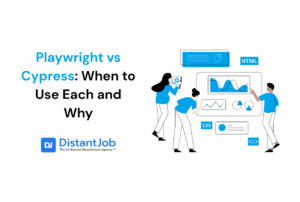When choosing a data persistence framework for your Swift app, ease of use is crucial, along with performance and long-term support.
With both Core Data and SwiftData being Apple’s two leading frameworks for local data persistence on iOS and macOS, the first difference you should know is that Core Data is the more mature framework, as it has been around for decades and is recognized as a powerful object graph and persistence framework. SwiftData is the new player in town, and the Swift-based API was just announced at WWDC 2023 as a more declarative and SwiftUI-friendly solution for persistence.
Regardless of their differences, both options are meant to achieve the same goal: save and manage data on an Apple device, with the aid of a database engine, often SQLite, running in the background.
In this article, we’ll compare the pros and cons of Core Data and SwiftData to help you decide which one to use. SwiftData has been around for two years now, so we have enough experience to make a fair comparison. Let’s start:
What is Core Data?
Core Data is Apple’s framework and main database tool for over 15 years. Think of it as a translator between your app and its database. Instead of writing complex database code, you work with simpler objects and relationships.
Pros :
- Core Data is great at dealing with complex object relationships.
- It is the most mature solution available, with possibly all bugs already discovered and resolved, and loads of documentation and education accessible online.
- Can manage a vast amount of data.
- It is properly designed for handling concurrency (when many things happen at once without the system slowing down).
- Core Data has a powerful migration tool that allows the database to be upgraded and modified as the app moves forward.
Cons:
- It is complex and very hard to learn.
- Core Data has too much boilerplate code (a lot of repetitive code).
- Is not always safe for use with multithreaded applications. (You need to follow many rules to make sure one thread is not affecting the other.)
- Core Data does not integrate well with SwiftUI.
What is SwiftData?
SwiftData is an intuitive and robust data persistence framework designed specifically for Swift applications, simplifying the tasks of data modeling and management. It came out in 2023 as Apple’s attempt to make the database work much simpler. It’s built on top of Core Data but hides most of the complexity.
Pros of SwiftData
- Apple’s SwiftData has much less boilerplate code.
- It is perfectly integrated with SwiftUI.
- Automatically syncs the data on all devices through iCloud.
- Apple’s SwiftData uses many modern-language features of Swift to ensure better typings and catch bugs before they even reach the customers.
- Apple’s SwiftData automatically saves your data so you don’t forget.
Cons (as of the year 2025)
- Apple’s SwiftData, as of the year 2025, is slower than Core Data.
- Has too much coupling between the persistence layer and the user interface.
- Lacks some functionality that exists in Core Data.
- Does automatic saving in a way that, on rare occasions, can silently fail.
- It is not stable. What works in iOS 17 or 18 might not work in later versions, as the product is expected to drastically change.
- Synchronizes with iCloud, but only for private data and not shared data (data that belongs to more than one user).
- Doesn’t have some functionalities that Core Data brings to the table, such as group by and fetch result controllers.
Side by Side Comparison on CoreData and SwiftData Frameworks
To choose the right framework for 2025 between SwiftData and CoreData, you need to look at several key factors that matter most for small business apps. We’ll examine each framework’s ease of use, learning curve, SwiftUI integration, performance, iCloud syncing capabilities, Apple’s long-term commitment, and migration options. Here’s how they compare:
| Difference | Core Data | SwiftData |
|---|---|---|
| Maturity & Stability | • Battle-tested since 2005; proven reliability.• Huge ecosystem of docs, sample code and third-party tools. | • Brand-new (iOS 17+); still settling but backed by Apple’s roadmap.• Community and resources are growing rapidly. |
| Ease of Use | • Steep learning curve—contexts, object lifecycles, verbose saves/fetches.• Boilerplate and threading rules can intimidate new devs. | • Model with @Model, auto-save, far less boilerplate.• Designed to feel like “just Swift code.” |
| SwiftUI Integration | • Works, but requires @FetchRequest, manual context handling, and extra glue. | • Built for SwiftUI—@Query gives live data updates with minimal code. |
| Features & Power | • Advanced batch ops, fine-grained merge policies, CloudKit multi-user sharing, rich predicates.• Runs on iOS 15/16 and every Apple platform. | • Auto CloudKit sync for single-user data; custom storage engines coming.• Lacks some power-user features (multi-user sharing, batch ops—yet). |
| Performance & Control | • Optimised for huge datasets; developers can tune fetch requests and memory use. | • Good default performance for typical apps, but less manual control; large datasets can consume more memory today. |
| Threading Model | • Strict thread confinement—powerful but easy to misuse. | • Abstracts most threading details; safer for beginners. |
| Future-Proofing | • Fewer new features announced; Apple’s focus is shifting away. | • Apple’s “new hotness”; likely to get yearly enhancements and Swift macro support. |
| OS Support | • Works on older OS versions—ideal if you must support legacy devices. | • Requires iOS 17 / macOS 14 or newer; limits audience on older hardware. |
| Risk & Unknowns | • Very low—edge-case bugs are well documented. | • Higher—some APIs still evolving; you may hit rare bugs with limited community answers. |
How Easy Are They to Use?
Core Data is notoriously difficult to learn. It’s one of those technologies that requires you to understand many complicated concepts, write lots of boilerplate code, and manage much of the wiring by yourself. Imagine learning how to drive a stick while also learning how to maintain the car and replace parts when necessary. Core Data is such a difficult system to master, and the code is quite verbose, which many developers find unpleasant to use. On a positive note, within the past 15 years, there have been many books, online courses, and articles written on the subject, which can make learning Core Data easier.
SwiftData, on the other hand, was created with the idea of simplifying the process as much as possible. You don’t have to create separate model files and a lot of configuration code to run it. Just by adding a few simple annotations to your existing Swift code, SwiftData attempts to automatically infer everything for you. I guess you could compare it to switching from driving a stick shift to driving an automatic car, where you just start driving.
Many developers have described SwiftData as much more enjoyable to use, and it really does not require much code to have persistence working.
The downside is that SwiftData is newer, so there are fewer tutorials and examples available when you run into problems.
Working with SwiftUI (Apple’s Modern Interface Framework)
Because many small business apps today use SwiftUI for their user interface, how each framework integrates with SwiftUI is crucial.
Core Data wasn’t built with SwiftUI in mind since it’s much older. You can make them work together, but it feels like connecting two different systems that don’t naturally fit. It works, but requires extra code and careful management to keep everything in sync.
SwiftData is fully integrated with SwiftUI, and it was designed at the same time that SwiftUI was created. They fit together perfectly. When you change the data in the model, the interface is automatically updated without writing any extra code. It’s almost a match made in heaven.
The catch is SwiftData only works on iOS 17 and newer, so if you need to support older devices, Core Data is your only option.
If you build a SwiftUI app, SwiftData offers a smoother integration. You can declare your data queries in the view with @Query and get live updates effortlessly. Core Data can still be used with SwiftUI (@FetchRequest gets the job done), but SwiftData feels more natural as it was built to integrate seamlessly with SwiftUI.
Performance (How Fast They Are)
In reality, when it comes to small-scale business applications performing regular tasks, there is no noticeable difference, which makes sense because SwiftData is built on top of Core Data and the performance of both systems is often comparable because it’s leveraging the same SQLite engine via Core Data internally, so reads/writes are comparable.
Core Data has been optimized over 15+ years and tends to be slightly faster with very large amounts of data. If you’re handling thousands of records, Core Data might have an advantage.
SwiftData sometimes uses a bit more memory and can be slightly slower with huge datasets, but for typical small business needs (like a customer database or inventory), the difference is negligible.
Syncing Across Devices (iCloud)
Many small business apps benefit from data syncing across devices (e.g., an owner’s iPhone and iPad) via iCloud. Both Core Data and SwiftData support CloudKit-based iCloud sync out of the box for an app’s private data.
Both can automatically sync your app’s data across all of a user’s devices through iCloud with very little setup required.
Core Data supports syncing personal data and also allows sharing data between different users (like employees collaborating). This is useful if multiple people need to access the same business data.
SwiftData easily syncs personal data but currently can’t share data between different users’ Apple IDs. So if you need multiple employees to share business data, Core Data has an advantage.
Both sync methods aren’t instant, with changes usually appear on other devices within seconds to minutes, depending on network conditions.
Long-term Support and Future
Core Data has been around for 15+ years and Apple will continue supporting it, but they’re not adding new features. It’s like a reliable old car that still runs but isn’t getting any upgrades.
SwiftData is where Apple is focusing their attention. They’re actively adding new features and improvements with each iOS update. It’s like the new car model that gets all the latest technology.
For a business app you plan to maintain for years, SwiftData aligns better with Apple’s future direction. You’re more likely to benefit from new features and improvements.
Switching from Core Data to SwiftData
Luckily, you can use both frameworks simultaneously and slowly move functionality from Core Data to SwiftData, so if you’re starting a new project from scratch, SwiftData is the default solution
You can also run both systems side-by-side, gradually moving features from Core Data to SwiftData over time.
If you’re starting a new app today, you can just choose SwiftData from the beginning. If you have an existing Core Data app that works fine, there’s no urgent need to convert it, but if you’re planning major updates, it might be worth considering.
Conclusion
While SwiftData is easier to learn, integrates better with modern Apple infrastructure, and is the future that Apple is betting on, Core Data is the more mature product with more documentation and education resources, and has the capability to handle certain complex functionalities that SwiftData won’t be able to deal with for a while. If we had to choose between them, it would be like this: for the vast majority of small-scale business applications, SwiftData is the superior option for a new project, unless your applications need to support multiple versions of iOS or have more complex data sharing requirements.
And if you need either a CoreData expert or an Ios developer with expertize in either frameworks, we are here for you. Just book a free consultation and let’s discuss your needs.





